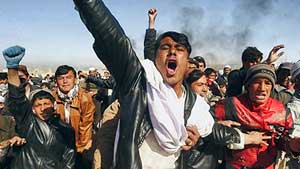Protests erupt across Afghanistan
By
G. Dunkel
Published Sep 15, 2010 4:50 PM
The threat to burn the Qur’an at a small church in Gainesville, Fla., on
the ninth anniversary of the attacks on the World Trade Center stirred up
worldwide outrage, especially in Muslim countries in Central and South
Asia.
|
Kabul, Afghanistan, Sept. 12.
|
Demonstrations erupted in Pakistan, India, Indonesia and Palestine even after
the church in question, under tremendous pressure from the U.S. political and
military establishment, said it would not go ahead with the planned
burning.
The biggest and most militant protests occurred in Afghanistan, where the
Qur’an has had a significant moral and political impact for centuries.
Afghanistan’s occupation by troops of the very country where the burning
was planned made the protests more significant.
Not only have the Afghan peoples rejected foreign occupation, but the U.S.
drone attacks that kill whole families have aroused great popular anger. At the
end of August, for example, in northeast Afghanistan, a nighttime raid by NATO
commandos left eight civilians dead and 12 wounded.
The local governor, Mohammed Ismail, said a group of tribal elders he had sent
to the village had returned with details. Among the dead were two women and a
child. ‘’It was a cruel act against the civilians,’’ he
said.
The mass media in the U.S. have tried to blame these political protests on the
Taliban, pointing to major demonstrations in the city of Jalalabad and south of
Kabul, where the Taliban have a major presence. CBS reported Sept. 9 that the
Taliban were distributing leaflets to imams south of Kabul to read at Friday
prayer service.
But a crowd estimated at 10,000 protested Sept. 10 on the streets of Faizabad,
the capital of Badakhshan, and one young protester was shot dead when a smaller
group attacked a German-run NATO base there, hurling stones at the outpost.
(Reuters, Sept. 11) What is significant, in addition to the death of a youth,
is that Badakhshan is an area where the Taliban have had a very small
presence.
The protests continued the next day. Four demonstrators were seriously wounded
when Afghan police opened fire as thousands tried to storm several government
buildings in Pul-e-Alam, the capital of Logar province, south of Kabul, a
provincial official told Reuters.
Protesters also gathered in the capital, Kabul, and in four other provinces,
mainly in the west of the country.
In western Ghor province, one of the poorest regions of Afghanistan, about
2,000 people marched in four districts of the province to condemn the planned
Qur’an burning. In Farah, another western province on the border with
Iran, hundreds gathered in Bala Blok district shouting anti-U.S. slogans.
(Agence France Press, Sept. 10)
BBC television showed demonstrators in the main northern city of Mazar-i-Sharif
marching through the streets with their fists high and burning a U.S. flag on
the grounds of the historic Blue Mosque.
A former Afghan prime minister, Ahmad Shah Ahmadzai, said of the
demonstrations: “This shows that the disaffection of the Afghans toward
Americans is very, very strong. It’s the result of all those killings of
civilians they keep doing.” (New York Times, Sept. 10)
The U.S. campaign supposedly “to win the hearts and minds” of the
Afghans has failed. The opposition to U.S. imperialism’s occupation can
organize quickly and politically to bring the masses out into the streets.
While the Taliban are obviously a major part of this opposition, other forces
are also involved. But it is in Washington’s interest in prosecuting its
war against the Afghan peoples to put the Taliban front and center because they
have been so thoroughly demonized for their socially reactionary positions.
For example, the U.S. puts forward the claim that the main source of funding
for the Taliban is their control of the opium-growing regions in Helmand and
other southern provinces. However, a recent article in Le Monde Diplomatique,
which relies on a U.S. House of Representatives report — “Warlord,
Inc.: Extortion and Corruption Along the U.S. Supply Chain in
Afghanistan” — makes it clear that a major source of Taliban
funding is the payments they get from U.S. subcontractors for delivering
supplies to the 200 or so bases the U.S. has in the country.
U.S. imperialism, a technological colossus, is confronting severe political
difficulties and a military stalemate in impoverished Afghanistan all because
of the resistance of the population to the war and occupation.
Articles copyright 1995-2012 Workers World.
Verbatim copying and distribution of this entire article is permitted in any medium without royalty provided this notice is preserved.
Workers World, 55 W. 17 St., NY, NY 10011
Email:
[email protected]
Subscribe
[email protected]
Support independent news
DONATE


